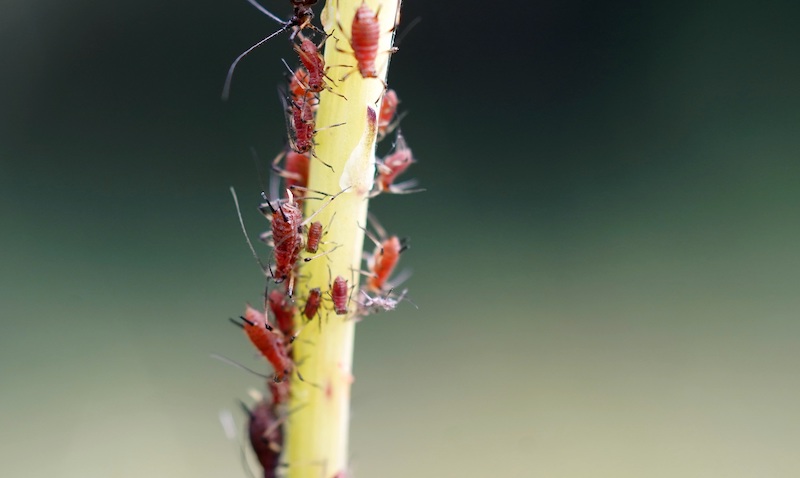Cheery yellow flowers signify warm weather and make the sunflower a lovely plant. The bold blooms are also appealing to pests, which can cause some unsightly trouble. Learning how to spot the signs of pest damage can help you treat minor issues before they get out of control. Understanding pests also makes it possible to prevent pest damage from happening.
Common Sunflowers Pests
Aphids
Aphids are small, sap-sucking insects. They latch onto plants and suck the sap from the stems, petals, and foliage, causing discoloration, leaf curling, and stunted growth. These pests can engulf a plant and cause a lot of damage. Aphids can be seen on plants, usually on the stems and undersides of leaves. Aside from damage and seeing the actual bugs, you know a plant has aphids if you spot their waste, known as honeydew. Honeydew appears as white specks that can turn black after it is overtaken by a fungus known as sooty mold.

Treating Aphids on Sunflowers
Immediately remove aphids from sunflowers by spraying the plant with a hose to dislodge the bugs. Once the bugs are removed, they are unable to climb back onto the plant, preventing further damage. Aphids are tiny, so removing an entire colony from a large plant is challenging and may require additional treatment. Treat aphid infestation by spraying the plant with horticultural oil or insecticidal soap. Remove any parts of the plant that have significant damage and destroy the removed sections so any surviving aphids cannot reproduce.
Preventing Aphids on Sunflowers
Prevention is often easier than treatment, so treat sunflowers to prevent aphid infestation from even starting. Proactively spray sunflowers with insecticidal soap or oil to ward off pests like aphids. Avoid over-fertilizing sunflowers because aphids like to feed on lush, healthy plants. Companion plantings like garlic, chives, and flowering onions can discourage aphids.
Lygus Bugs
Lygus bugs are winged insects in shades of reddish-brown or green. These fast-moving insects suck nutrients out of the plant and target the seeds. Lygus bugs are primarily a problem on plants grown for their edible seeds, but even if you don’t intend to snack on the seeds, they are damaging. Discolored seeds are a sign of Lygus bug damage.

Treating Lygus Bugs on Sunflowers
Unfortunately, Lygus bugs are usually gone when the damage is visible. When you realize there is a problem, the damage is already done, but fortunately, there will not be further damage.
Preventing Lygus Bugs on Sunflowers
Prevent Lygus bug infestation by not planting broadleaf evergreen plants nearby sunflowers. Mature Lygus bugs often move to these broadleaf plants and can return to the sunflowers to lay eggs, starting the infestation cycle over.
Sunflower Beetles
Sunflower beetles only infest sunflower plants. These insects start as plump, light green larvae that transition into round insects with brown heads and cream-colored wings with brown stripes. These pests eat sunflower foliage. Larvae eat leaves, leaving a tissue-thin portion, while adult sunflower beetles eat entirely through the leaves, creating holes.
Treating Sunflower Beetles on Sunflowers
Insecticidal oils or soaps are effective at treating sunflower beetles. Spray the plant every few days to remove eggs, larvae, and mature adult beetles. It may take several rounds of treatment to remove all insects and prevent future generations from infesting the plant. Remove damaged growth to encourage the plant to redirect energy into new healthy growth.
Preventing Sunflower Beetles on Sunflowers
Planting annual sunflowers later in the spring can help prevent sunflower beetle infestation. This is not an effective strategy for perennial sunflowers, but certain types of ladybugs and lacewings eat the sunflower beetle eggs, so encouraging beneficial insects is helpful. Prevent sunflower beetle infestation by spraying sunflower plants with horticultural oil or insecticidal soap.
Sunflower Moths
Sunflower moths damage the flowers and can be very destructive. Mature sunflower moths lay their eggs on the flowers. Young-stage larvae eat pollen, while later-stage larvae eat the sunflower seeds and the connective tissue in the flower. The larvae have white bodies with brown stripes. Damage from sunflower moths leaves the plant more susceptible to fungus, which will rot what is left of the flower. The presence of sunflower moths is often identifiable by their dark droppings, which appear on the flowers. Webbing on the flowers is also a sign of sunflower moth larvae.
Treating Sunflower Moths on Sunflowers
Insecticidal oils and soaps are proven to treat sunflower moths and their larvae. Spray the plant if you see signs of damage or indicators of the pest’s presence. Apply the treatment under the leaves, where mature moths typically rest during the day. Remove damaged growth to restrict the reproduction of future generations, and destroy any infected plant part to contain the infestation.
Preventing Sunflower Moths on Sunflowers
Beneficial insects, like wasps, are effective at controlling sunflower moths. Proactively treating sunflowers with horticultural oil and insecticidal soap can also reduce the risk of sunflower moth infestation.
Sunflower Pests Chart
|
Pest |
Identifying |
Treating |
|
Aphids |
Small, pear-shaped insects, with soft bodies |
Spray the plant with a hose to dislodge bugs |
|
Lygus Bugs |
Winged insects in shades of reddish-brown or green |
Usually gone when the damage is visible |
|
Sunflower Beetles |
Round insects with brown heads and cream-colored wings with brown stripes |
Spray with insecticidal oils or soaps every few days |
|
Sunflower Moths |
Dark droppings, which appear on the flowers |
Spray with insecticidal oils and soaps |
Sources: "Sunflower Insects: Scouting and Identification." The University of Vermont. uvm.edu
 |
Author Alison Cotsonas - Published 05-01-2023 |
